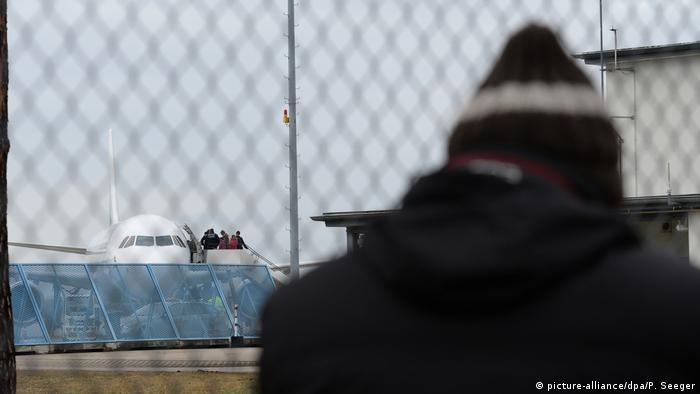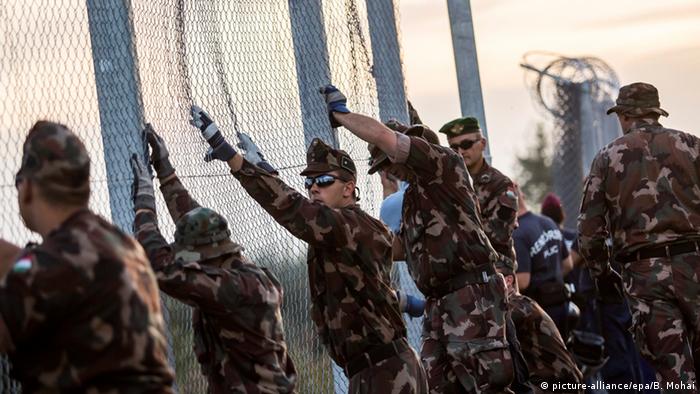Germany plans to fast-track deportations of failed asylum-seekers
Germany’s Interior Ministry has proposed new measures to monitor and deport failed asylum-seekers. Interior Minister Horst Seehofer has said he is also looking at ways to repatriate known criminals to Syria.

The German Interior Ministry on Sunday confirmed plans to facilitate and accelerate deportations of failed asylum-seekers along with those who should have their asylum requests processed in another EU country under the so-called Dublin rules.
One of the measures submitted to state authorities is bolstering asylum-seekers’ night-time reporting requirements. Another would implement a chip system to record when asylum-seekers pick up their mail to ensure they have received a deportation order. Such systems are already in use in the states of Hesse and Lower Saxony.
Others include securing “no-name bookings” on flights so that a seat can still be used by a potential deportee if the original failed asylum-seeker is unable to make the flight. It provides authorities with more flexibility to use reserved seats on flights, according to the ministry.
Read more: Underage refugees in Germany increasingly going missing
More tools for states
An Interior Ministry spokesperson said the measures would give state authorities tools to monitor and deport failed asylum-seekers. It would also give local authorities the ability to arrest and hold failed asylum-seekers in jail if they are deemed flight risks.
The measures appear to address concerns that arose in the wake of the 2016 terror attack on a Christmas market in Berlin. The perpetrator, Anis Amri, was a known criminal and failed asylum-seeker from Tunisia who managed to elude authorities in the run-up to the attack.
Read more: Anis Amri: How a terror suspect eluded German authorities
The plans were first reported by the Berlin-based newspaper Bild am Sonntag and later confirmed by the Interior Ministry.
 Deportations from Germany, especially to Afghanistan, have triggered demonstrations. Protesters have argued that some home countries aren’t safe.
Deportations from Germany, especially to Afghanistan, have triggered demonstrations. Protesters have argued that some home countries aren’t safe.
‘Volatile situation’
Confirmation of the plans comes days after the ministry said it is considering revoking its freeze on repatriating Syrian migrants.
On Friday, German Interior Ministry Horst Seehofer, known for his hard-line policy toward irregular migrants, told the Redaktionsnetzwerk Deutschland group of local newspapers that authorities are examining whether they can deport Syrians who are known criminals.
But such moves remain controversial, and even more so after the German Foreign Ministry published a classified report on Syria, saying evidence shows a “complex, still difficult and volatile situation” in the war-torn country.
In 2015, Germany received nearly 900,000 refugees under Chancellor Angela Merkel’s open-door policy. Many of them were fleeing war and extreme poverty in the Middle East, Asia and Africa. At the time, Merkel cited the situation in Syria for her decision.
Read more: Paying the price for helping refugees in Germany
Every evening, DW’s editors send out a selection of the day’s hard news and quality feature journalism. You can sign up to receive it directly here.

Fleeing war and poverty
In late 2014, with the war in Syria approaching its fourth year and Islamic State making gains in the north of the country, the exodus of Syrians intensified. At the same time, others were fleeing violence and poverty in countries such as Iraq, Afghanistan, Eritrea, Somalia, Niger and Kosovo.

Seeking refuge over the border
Vast numbers of Syrian refugees had been gathering in border-town camps in neighboring Turkey, Lebanon and Jordan since 2011. By 2015, with the camps full to bursting and residents often unable to find work or educate their children, more and more people decided to seek asylum further afield.

A long journey on foot
In 2015 an estimated 1.5 million people made their way on foot from Greece towards western Europe via the “Balkan route”. The Schengen Agreement, which allows passport-free travel within much of the EU, was called into question as refugees headed towards the wealthier European nations.

Desperate sea crossings
Tens of thousands of refugees were also attempting the perilous journey across the Mediterranean on overcrowded boats. In April 2015, 800 people of various nationalities drowned when a boat traveling from Libya capsized off the Italian coast. This was to be just one of many similar tragedies – by the end of the year, nearly 4,000 refugees were reported to have died attempting the crossing.

Pressure on the borders
Countries along the EU’s external border struggled to cope with the sheer number of arrivals. Fences were erected in Hungary, Slovenia, Macedonia and Austria. Asylum laws were tightened and several Schengen area countries introduced temporary border controls.

Closing the open door
Critics of German Chancellor Angela Merkel’s “open-door” refugee policy claimed it had made the situation worse by encouraging more people to embark on the dangerous journey to Europe. By September 2016, Germany had also introduced temporary checks on its border with Austria.

Striking a deal with Turkey
In early 2016, the EU and Turkey signed an agreement under which refugees arriving in Greece could be sent back to Turkey. The deal has been criticized by human rights groups and came under new strain following a vote by the European Parliament in November to freeze talks on Turkey’s potential accession to the EU.

No end in sight
With anti-immigration sentiment in Europe growing, governments are still struggling to reach a consensus on how to handle the continuing refugee crisis. Attempts to introduce quotas for the distribution of refugees among EU member states have largely failed. Conflicts in the Middle East and elsewhere show no signs coming to an end, and the death toll from refugee sea crossings is on the rise.